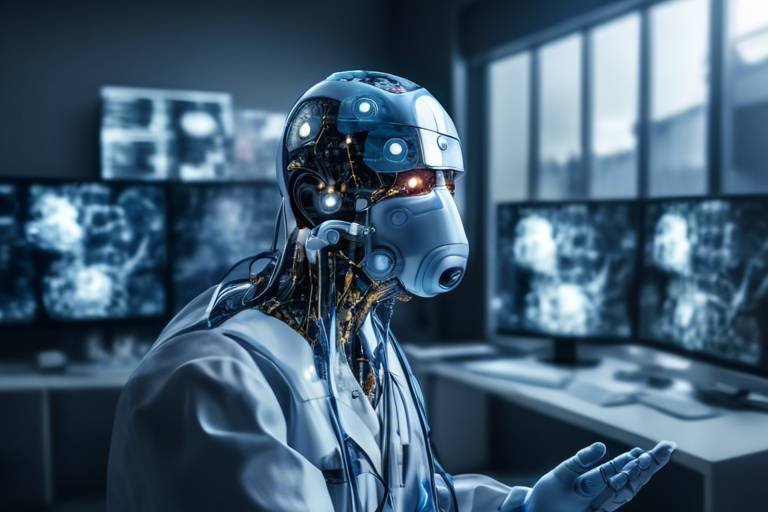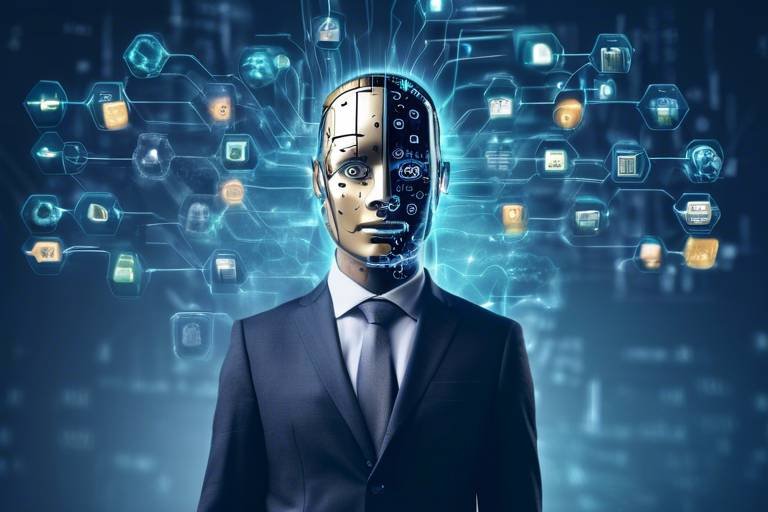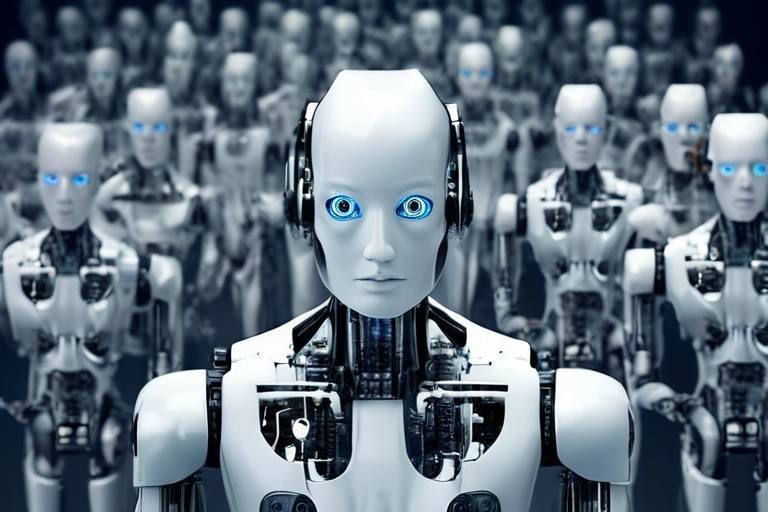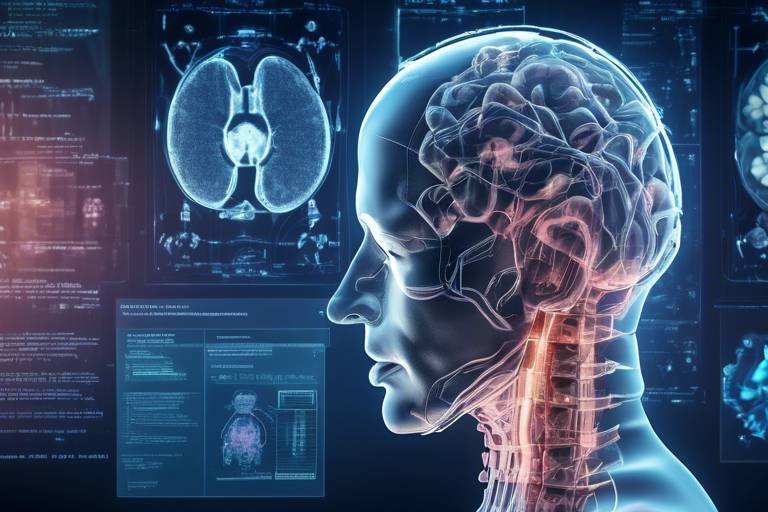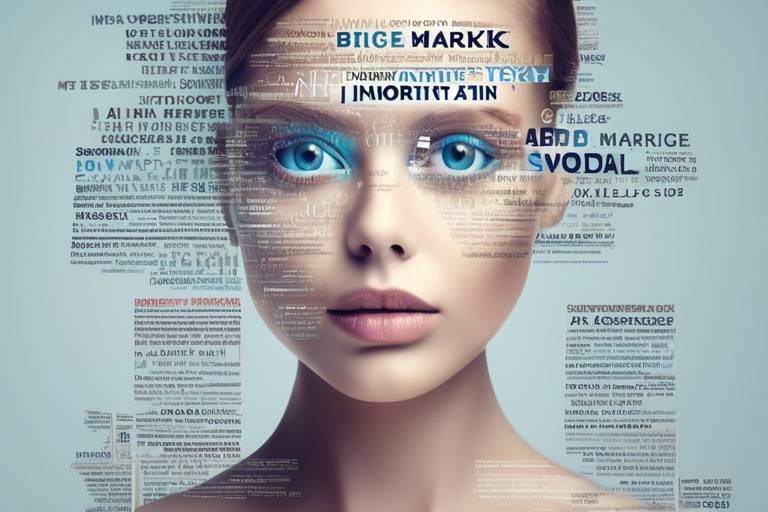Advancements in AI: Deepfakes and Beyond
Artificial Intelligence (AI) has rapidly evolved over the past few years, bringing forth innovations that were once confined to the realms of science fiction. Among these advancements, deepfake technology stands out as both fascinating and alarming. It allows users to create hyper-realistic images and videos that can mimic real people with astonishing accuracy. But the implications of such technology extend far beyond mere entertainment; they challenge our perceptions of reality and raise critical questions about trust and authenticity in the digital age.
As we delve deeper into the world of AI, it's crucial to understand how deepfakes work. At their core, deepfakes utilize complex algorithms and machine learning techniques to analyze vast amounts of data, including facial expressions, voice patterns, and even body language. This technology can generate content that is almost indistinguishable from real footage, making it a double-edged sword. On one hand, it opens up new avenues for creativity and storytelling, while on the other, it poses serious risks concerning misinformation and privacy violations.
The rise of deepfakes has sparked a wave of interest across various industries, from entertainment to journalism. As we explore the implications of this technology, we must also consider the ethical dilemmas it presents. How do we navigate a world where seeing is no longer believing? What measures can we put in place to protect individuals from malicious uses of deepfake technology? These questions are at the forefront of discussions surrounding AI advancements, as society grapples with the balance between innovation and responsibility.
In the following sections, we will examine the impact of deepfakes on media, the creative industries, and the broader implications for society. We will also explore advancements in AI beyond deepfakes, highlighting how this technology is transforming sectors like healthcare and finance. Buckle up, because the journey through the world of AI is just beginning, and it's sure to be a wild ride!
Deepfakes are a product of advanced AI techniques, primarily utilizing Generative Adversarial Networks (GANs). This innovative approach involves two neural networks—the generator and the discriminator—working in tandem to create realistic images and videos. The generator creates fake content, while the discriminator evaluates it against real data. This back-and-forth process continues until the generator produces content that is virtually indistinguishable from reality.
As deepfake technology becomes more accessible, the ethical implications become increasingly significant. The potential for misinformation is one of the most pressing concerns. Deepfakes can be used to create false narratives, manipulate public opinion, or even damage reputations. Imagine a world where a politician's speech can be altered to say anything; the consequences could be catastrophic.
Traditional journalism is facing unprecedented challenges due to the rise of deepfake technology. News organizations are adapting by implementing stricter verification processes and leveraging AI tools to detect manipulated content. The integrity of news reporting is paramount, and media outlets are investing in technologies that can identify deepfakes and ensure the credibility of their information.
In response to the growing threat of deepfakes, various strategies are being employed to combat misinformation. These include:
- Developing AI tools that can detect deepfakes with high accuracy.
- Implementing educational programs to inform the public about the existence and dangers of deepfakes.
- Establishing regulatory measures to hold creators of malicious deepfakes accountable.
The legal landscape surrounding deepfakes is evolving as lawmakers recognize the need for regulations. Current laws are often inadequate to address the unique challenges posed by this technology. Future regulations may include:
- Stricter penalties for malicious use of deepfake technology.
- Clear guidelines for content creators regarding the ethical use of AI.
- Collaboration between tech companies and governments to develop effective countermeasures.
Despite the ethical concerns, the entertainment industry is leveraging deepfake technology to push creative boundaries. Filmmakers are using this technology to enhance storytelling, create stunning visual effects, and even resurrect beloved actors for new roles. The ability to manipulate visual content opens up a realm of possibilities, but it also raises questions about authenticity and the future of acting.
While deepfakes have garnered significant attention, AI advancements extend far beyond this technology. In sectors like healthcare and finance, AI is making strides that are transforming the way we approach various challenges. For instance, AI is revolutionizing healthcare by enabling predictive analytics that can forecast patient outcomes and streamline treatment processes.
In healthcare, AI technologies are improving patient care by providing personalized medicine tailored to individual needs. This shift towards predictive analytics is helping healthcare providers make informed decisions, ultimately leading to better patient outcomes. Imagine a world where your doctor can predict health issues before they arise—this is the future AI is paving.
In the finance sector, AI is enhancing risk assessment and fraud detection, making financial services more secure and efficient. Financial institutions are using AI algorithms to analyze market trends, identify potential risks, and develop investment strategies that are more informed than ever before. It's a game-changer for investors looking to navigate the complex world of finance.
What are deepfakes?
Deepfakes are hyper-realistic images and videos created using AI technology that can mimic real people, often blurring the line between reality and fabrication.
What are the ethical concerns surrounding deepfakes?
The primary ethical concerns include misinformation, privacy violations, and the potential for malicious use in various contexts.
How is the media adapting to deepfakes?
Media organizations are implementing stricter verification processes and utilizing AI tools to detect manipulated content to maintain credibility.
What are some applications of AI beyond deepfakes?
AI is transforming sectors like healthcare and finance through predictive analytics, personalized medicine, and enhanced risk assessment.

Understanding Deepfakes
Deepfakes are a fascinating yet unsettling product of modern artificial intelligence. At their core, they utilize advanced machine learning techniques, particularly a subset known as Generative Adversarial Networks (GANs). This technology enables computers to create hyper-realistic images and videos that can convincingly mimic real people, often making it difficult for viewers to discern what is genuine and what is fabricated. Imagine a world where a video of a public figure saying something completely outrageous could be nothing more than a cleverly crafted illusion—this is the reality we face with deepfakes.
The process behind deepfakes involves two neural networks competing against each other. One network generates fake content, while the other evaluates its authenticity. Over time, this back-and-forth leads to increasingly realistic outputs. The implications of such technology are vast, ranging from entertainment to misinformation. For instance, in the film industry, deepfake technology can be used to seamlessly de-age actors or create realistic stunt doubles, enhancing storytelling in ways previously thought impossible. However, the same technology can also be weaponized to create misleading videos that could influence public opinion or incite chaos.
While the potential applications of deepfakes are intriguing, they also raise significant ethical questions. Consider this: what happens when a deepfake video goes viral, showing a politician making inflammatory statements? The damage to their reputation could be irreversible, even if the video is later proven to be fake. This blurring of reality and fabrication challenges our understanding of trust, authenticity, and accountability in the digital age.
Furthermore, deepfakes are not just limited to video; they can also create realistic audio clips. Imagine receiving a phone call from someone you trust, only to find out later that it was a deepfake designed to manipulate or deceive you. As this technology continues to evolve, it becomes increasingly crucial for individuals and organizations to stay informed and vigilant.
To better understand the impact of deepfakes, let’s look at some potential applications:
- Entertainment: Filmmakers can create stunning visual effects or resurrect performances from past actors.
- Education: Deepfakes can be used to create engaging educational content, bringing historical figures to life.
- Advertising: Brands can leverage deepfake technology to create personalized ads featuring celebrity endorsements.
In conclusion, while deepfakes represent a remarkable advancement in AI technology, they also pose serious challenges that society must grapple with. As we continue to explore the capabilities of AI, understanding deepfakes and their implications is essential to navigate the complex landscape of truth and deception in our increasingly digital world.

Ethical Implications
As we dive into the realm of deepfake technology, it becomes glaringly evident that the ethical implications are as profound as the technology itself. With the ability to create hyper-realistic images and videos, deepfakes blur the lines between reality and fabrication, raising critical questions about trust, truth, and accountability. Imagine waking up one day to find a video of a public figure saying something they never actually said. The potential for misinformation is staggering, and this is just the tip of the iceberg.
One of the most pressing concerns is the issue of misinformation. In an age where information spreads like wildfire, deepfakes can be weaponized to manipulate public opinion or tarnish reputations. For instance, a well-crafted deepfake can easily mislead viewers into believing a fabricated narrative, which can have real-world consequences. This raises the question: how can we discern what’s real in a world where reality can be manufactured with a few clicks?
Furthermore, the privacy violations associated with deepfake technology cannot be overlooked. Individuals can find themselves victims of deepfake pornography or other malicious uses that exploit their likeness without consent. The emotional and psychological toll on victims can be devastating, leading to a loss of dignity and trust. It’s like having your identity hijacked, and the implications stretch beyond personal trauma to societal norms about consent and respect.
In response to these ethical dilemmas, various stakeholders are stepping up to address the challenges posed by deepfakes. Here are some of the strategies being employed:
- Education: Increasing awareness about deepfake technology can empower individuals to critically evaluate the media they consume.
- Technology Solutions: Developers are creating tools to detect deepfakes, helping to restore some semblance of trust in visual media.
- Policy Making: Governments and organizations are beginning to draft regulations aimed at curbing the misuse of deepfake technology.
As we navigate these murky waters, it’s crucial to consider the impact on media. Traditional journalism is facing unprecedented challenges as deepfakes proliferate. News organizations are now tasked with not only reporting the news but also verifying its authenticity. This shift is forcing journalists to adopt new tools and methods, creating a more rigorous standard for what constitutes credible news. It’s a bit like trying to find a needle in a haystack, where the needle might just be a genuine piece of information.
Moreover, the legal frameworks surrounding deepfakes are also evolving. Current laws often lag behind technological advancements, leaving a gap that can be exploited. As deepfake technology continues to advance, lawmakers are faced with the challenge of crafting regulations that protect individuals without stifling innovation. This balancing act is akin to walking a tightrope, where one misstep could lead to significant consequences.
In conclusion, the ethical implications of deepfake technology are vast and complex. As we embrace the advancements in AI, we must also take a step back and critically assess how these technologies are used. Only through a collective effort of education, technological innovation, and robust policy-making can we hope to navigate the ethical landscape shaped by deepfakes and other AI advancements.
- What are deepfakes? Deepfakes are synthetic media created using artificial intelligence that can produce realistic images and videos of people doing or saying things they never actually did.
- What are the ethical concerns surrounding deepfakes? Key concerns include misinformation, privacy violations, and the potential for manipulation of public opinion.
- How can we combat the negative effects of deepfakes? Strategies include education on media literacy, development of detection technologies, and the establishment of legal regulations.
- Are there any laws regulating deepfakes? While some laws are evolving, many jurisdictions still lack comprehensive regulations specifically addressing the implications of deepfake technology.

Impact on Media
In today's fast-paced digital landscape, the emergence of deepfake technology has dramatically reshaped the media industry. Imagine flipping through your favorite news outlet and coming across a video of a public figure saying something utterly outrageous. It sounds alarming, right? This is the reality we face as deepfakes blur the lines between truth and deception. The implications are staggering, especially for traditional journalism, which has always prided itself on delivering accurate and reliable information.
As deepfakes become more sophisticated, media organizations are grappling with the challenge of verifying content authenticity. The once straightforward task of confirming whether a video or image is genuine has transformed into a complex puzzle. Journalists are now required to employ advanced techniques and tools to discern what is real and what is fabricated. This shift not only increases the workload for journalists but also places a significant burden on their credibility.
To adapt to this new reality, many news organizations are investing in technologies that can detect deepfakes. For instance, companies are developing algorithms that analyze videos for inconsistencies in facial movements, audio synchronization, and even lighting conditions. These tools are crucial in helping journalists uphold their integrity and provide the public with trustworthy information. However, the challenge remains: as detection technology evolves, so too do the methods used to create deepfakes.
Moreover, the impact of deepfakes extends beyond just news media. Social media platforms are facing a torrent of manipulated content, leading to widespread misinformation. Users often share videos without verifying their authenticity, which can lead to viral spread of false narratives. This phenomenon has prompted platforms like Facebook and Twitter to implement stricter content moderation policies. They are now prioritizing fact-checking and labeling potentially misleading content to protect their users from being misled.
In light of these challenges, media organizations are also focusing on educating their audiences about the dangers of deepfakes. This involves creating awareness campaigns that highlight the importance of critical thinking and media literacy. After all, in an age where anyone with a smartphone can create convincing fake content, it’s more important than ever for consumers to question what they see online. Here are some key strategies that media organizations are employing:
- Investing in Technology: Many outlets are adopting AI-driven tools to detect deepfakes before they go live.
- Collaborating with Experts: News organizations are partnering with tech companies and academic institutions to stay ahead of emerging threats.
- Public Awareness Campaigns: Educating the audience about deepfakes and how to identify them is becoming a priority.
Ultimately, the rise of deepfakes presents both challenges and opportunities for the media. While the threat of misinformation is real, it also pushes journalists and media organizations to innovate and adapt. By embracing new technologies and fostering a culture of transparency, the media can strive to maintain its role as a trustworthy source of information in an increasingly complex digital world. As we navigate these uncharted waters, one thing is clear: the fight for truth in media has never been more crucial.
Q: What are deepfakes?
A: Deepfakes are synthetic media in which a person’s likeness is replaced with someone else’s, often using advanced artificial intelligence techniques.
Q: How do deepfakes affect journalism?
A: They challenge the credibility of news organizations, as journalists must now verify the authenticity of content more rigorously.
Q: What measures are being taken to combat deepfakes?
A: Media organizations are investing in detection technology, collaborating with tech experts, and raising public awareness about misinformation.
Q: Can deepfakes be used for positive purposes?
A: Yes, deepfake technology can be used creatively in film and entertainment, but it also requires responsible usage to avoid ethical pitfalls.

Combating Misinformation
As deepfake technology continues to evolve, the challenge of becomes increasingly critical. With the ability to create highly convincing fake videos and audio, the potential for misuse is vast, leading to a reality where discerning fact from fiction is more challenging than ever. So, how do we tackle this growing concern? Various strategies are being implemented across multiple fronts to preserve the integrity of information.
Firstly, technology itself is being harnessed to fight back. Advanced algorithms and machine learning models are being developed to detect deepfakes before they can spread. These systems analyze various characteristics of media, such as inconsistencies in facial movements, audio discrepancies, and even pixel-level anomalies that may indicate manipulation. For example, deepfake detection tools are being integrated into social media platforms, helping to flag suspicious content before it goes viral.
Moreover, media literacy is becoming an essential skill in the digital age. Educating the public about the existence of deepfakes and other forms of misinformation is crucial. By fostering a culture of skepticism and critical thinking, individuals can better evaluate the authenticity of the content they consume. Schools and organizations are increasingly offering workshops and resources aimed at enhancing media literacy, teaching people how to spot deepfakes and discern credible sources.
In addition to technological and educational measures, regulatory frameworks are also evolving. Governments and organizations are recognizing the need for laws that specifically address the creation and distribution of deepfakes. This includes potential penalties for malicious use and guidelines for ethical AI practices. As legislation catches up with technology, it is vital to strike a balance between innovation and accountability, ensuring that creativity is not stifled while protecting the public from harm.
As we navigate this complex landscape, collaboration among tech companies, governments, and civil society is essential. By working together, we can develop comprehensive strategies that not only combat misinformation but also promote a healthier information ecosystem. The fight against deepfakes is not just about technology; it’s about fostering trust and transparency in our media. Only then can we hope to maintain the integrity of information in an age where reality can be so easily manipulated.

Legal Frameworks
The emergence of deepfake technology has prompted a significant reevaluation of existing legal frameworks. As these hyper-realistic manipulations of video and audio become increasingly sophisticated, lawmakers are grappling with how to regulate their use effectively. The challenge lies not only in the technology itself but also in the myriad ways it can be misused, from creating misleading political content to infringing on personal privacy.
Currently, many countries are relying on existing laws related to fraud, copyright, and defamation to address the challenges posed by deepfakes. However, these laws often fall short in dealing with the unique aspects of deepfake technology. For instance, traditional definitions of identity theft may not encompass the digital impersonation enabled by deepfakes, leaving a gap that can be exploited. As a result, new legislation is being proposed to specifically target the creation and distribution of deepfakes.
One example of such legislation is the proposed DEEPFAKES Accountability Act in the United States, which aims to criminalize the malicious use of deepfake technology. This act seeks to establish clear penalties for individuals who create or distribute deepfakes with the intent to harm others. Similarly, countries like the UK and Australia are also exploring legislative measures to combat the spread of deepfakes and protect individuals from potential harm.
Moreover, the legal landscape is further complicated by the international nature of the internet. A deepfake created in one country can easily circulate globally, making it challenging for any single jurisdiction to enforce its laws effectively. This calls for a coordinated international effort to establish a regulatory framework that can transcend borders.
As lawmakers continue to develop these frameworks, it’s crucial to strike a balance between regulation and freedom of expression. Overly stringent laws could stifle creativity and innovation, especially in fields like entertainment where deepfake technology can be used for harmless or even beneficial purposes. Therefore, ongoing dialogue among technologists, legal experts, and ethicists is essential to create a comprehensive approach that not only addresses the risks but also recognizes the potential benefits of this technology.
In summary, while the legal frameworks surrounding deepfakes are still in their infancy, the need for clear, effective regulations is becoming increasingly urgent. As we move forward, it will be essential to monitor the developments in this area closely and adapt our legal systems to meet the challenges posed by this rapidly evolving technology.
- What are deepfakes? Deepfakes are synthetic media where a person’s likeness is replaced with someone else’s using artificial intelligence, creating hyper-realistic images and videos.
- How can deepfakes be used positively? Deepfakes can enhance storytelling in films, create realistic visual effects, and even be used in training simulations for various industries.
- What are the risks associated with deepfakes? The primary risks include misinformation, identity theft, and privacy violations, which can lead to significant social and legal consequences.
- Are there laws against deepfakes? Yes, some countries are developing specific laws to address the malicious use of deepfakes, while others are using existing laws related to fraud and defamation.
- How can I protect myself from deepfake misuse? Being aware of the technology and verifying sources of information can help mitigate the risks associated with deepfakes.

Applications in Entertainment
In the world of entertainment, deepfake technology is not just a buzzword—it's a revolutionary tool that is reshaping how stories are told and experienced. Imagine watching your favorite movie and seeing a beloved actor seamlessly transformed into a younger version of themselves. This isn't just a fantasy anymore; it's a reality brought to life by artificial intelligence. Filmmakers are now able to create stunning visual effects that were once thought to be impossible, blurring the lines between reality and imagination.
One of the most exciting applications of deepfake technology in entertainment is in the realm of character development. By using AI-generated imagery, creators can craft characters that evolve in ways that resonate deeply with audiences. For instance, a character could age or change appearance over the course of a series, allowing for a richer storytelling experience. This technology enables filmmakers to explore complex narratives without the constraints of traditional makeup or CGI, making it easier to convey emotions and plot twists effectively.
Moreover, deepfakes are also being used in post-production to enhance scenes. Imagine a scenario where a director wants to change an actor's expression in a particular shot. Instead of reshooting the entire scene, AI can adjust the actor's face in the existing footage, saving both time and resources. This capability not only streamlines the production process but also opens the door for creative possibilities that were previously unimaginable.
However, the use of deepfake technology in entertainment isn't without its challenges. While it offers incredible opportunities for creativity, it also raises questions about authenticity and consent. For example, using an actor's likeness without their permission can lead to serious ethical dilemmas. To navigate these waters, the industry is beginning to establish guidelines and best practices to ensure that deepfake technology is used responsibly.
As we look to the future, it’s clear that deepfake technology will continue to play a pivotal role in shaping the entertainment landscape. Whether it's through enhancing visual storytelling, creating immersive experiences, or even reviving iconic performances from the past, the possibilities are endless. The key will be finding a balance between innovation and ethical responsibility, ensuring that this powerful tool is used to enrich our entertainment experiences without crossing moral boundaries.
- What is a deepfake? A deepfake is a synthetic media in which a person’s likeness is replaced with someone else’s using artificial intelligence.
- How is deepfake technology used in movies? Filmmakers use deepfake technology to create realistic special effects, age characters, or even resurrect performances of deceased actors.
- Are there ethical concerns surrounding deepfakes? Yes, there are significant ethical concerns regarding consent, authenticity, and the potential for misinformation.
- What are some regulations regarding deepfake use? Regulations are evolving, with some jurisdictions beginning to implement laws that address the misuse of deepfake technology.

Advancements Beyond Deepfakes
The world of artificial intelligence (AI) is a vast ocean, and while deepfakes often steal the spotlight, there are countless other advancements making waves across various industries. These innovations are not just reshaping the way we interact with technology; they are redefining entire sectors, enhancing efficiency, and improving outcomes in ways we never thought possible. From healthcare to finance, AI is proving to be a game-changer, and it's high time we dive into these exciting developments.
In healthcare, for instance, AI is emerging as a powerful ally. Imagine a world where doctors can predict diseases before they manifest, or where personalized treatment plans are tailored to an individual's genetic makeup. This isn't science fiction; it's happening right now. AI algorithms are being trained on vast datasets to identify patterns that humans might overlook. For example, predictive analytics can analyze patient histories to forecast potential health issues, allowing for early interventions that save lives. This capability is particularly crucial in managing chronic diseases like diabetes and heart conditions, where timely action can make all the difference.
Moreover, AI is streamlining administrative processes in healthcare settings. Tasks that once consumed countless hours—such as scheduling, billing, and patient record management—are becoming automated. This not only reduces the burden on healthcare professionals but also minimizes human error, leading to more accurate and efficient operations. The result? More time for doctors to focus on what they do best: caring for patients.
Now, let’s shift gears to the financial sector, where AI is revolutionizing how we approach risk and fraud. Financial institutions are leveraging AI to enhance their risk assessment processes, utilizing algorithms that can analyze market trends and customer behaviors with incredible precision. This technology allows banks to make more informed lending decisions, ultimately reducing the likelihood of defaults and bankruptcies.
Additionally, fraud detection has taken a giant leap forward thanks to AI. Traditional methods of monitoring transactions are often reactive, catching fraudulent activities after they've occurred. However, AI systems can analyze patterns in real-time, flagging suspicious transactions and alerting authorities before significant damage is done. This proactive approach not only protects consumers but also safeguards the financial institutions themselves.
To illustrate the impact of AI in these sectors, consider the following table that highlights some key advancements:
| Industry | AI Application | Impact |
|---|---|---|
| Healthcare | Predictive Analytics | Early disease detection and personalized treatment |
| Healthcare | Administrative Automation | Streamlined processes and reduced errors |
| Finance | Risk Assessment | Informed lending decisions and reduced defaults |
| Finance | Fraud Detection | Proactive alerts and minimized losses |
As we look to the future, it’s clear that the advancements in AI are not just limited to deepfakes. The potential for innovation is limitless, and as technology continues to evolve, we can expect even more groundbreaking applications that will change the way we live and work. The key is to harness these advancements responsibly, ensuring that while we enjoy the benefits, we also address the ethical considerations that come with them. After all, technology is only as good as the intent behind it.
- What are deepfakes? Deepfakes are AI-generated images or videos that create hyper-realistic representations, often used to manipulate reality.
- How is AI used in healthcare? AI is used for predictive analytics, personalized medicine, and streamlining administrative tasks, improving patient outcomes.
- What impact does AI have on finance? AI enhances risk assessment, fraud detection, and overall financial decision-making processes.
- Are there ethical concerns with AI advancements? Yes, ethical concerns include privacy violations, misinformation, and the potential for misuse of technology.

AI in Healthcare
Artificial Intelligence (AI) is not just a buzzword in the tech world; it’s a game-changer, especially in the realm of healthcare. Imagine a world where doctors can predict diseases before they manifest, where treatments are tailored specifically to your genetic makeup, and where administrative tasks are streamlined to give healthcare professionals more time with patients. This isn’t science fiction; it’s happening now, thanks to the rapid advancements in AI technology.
The integration of AI in healthcare is multifaceted, impacting everything from diagnostics to patient care. For instance, AI algorithms can analyze medical images with incredible accuracy, often surpassing human capabilities. This means that conditions like cancer can be detected at much earlier stages, significantly improving patient outcomes. Moreover, AI can sift through vast amounts of data to identify patterns that humans might miss, leading to more accurate diagnoses and treatment plans.
One of the most exciting applications of AI is in the field of predictive analytics. By analyzing historical health data, AI can forecast potential health risks for individuals. For example, if you have a family history of diabetes, AI can provide insights into your lifestyle choices and suggest preventive measures. This proactive approach not only empowers patients but also helps healthcare providers allocate resources more efficiently.
Another area where AI shines is in personalized medicine. With the advent of genomics, healthcare providers can now tailor treatments based on a patient's unique genetic profile. AI systems can analyze genetic data alongside other health information to recommend the most effective therapies, minimizing trial and error in treatment. This is particularly beneficial in oncology, where targeted therapies can significantly improve survival rates.
Moreover, AI is revolutionizing the administrative side of healthcare. Tasks like scheduling, billing, and patient follow-ups, which often consume a significant amount of time, can be automated. This not only reduces the burden on healthcare staff but also enhances the patient experience by ensuring timely responses and follow-ups.
| AI Applications in Healthcare | Description |
|---|---|
| Diagnostic Imaging | AI algorithms analyze medical images to detect diseases with high accuracy. |
| Predictive Analytics | AI forecasts potential health risks based on historical data. |
| Personalized Medicine | Treatments tailored to individual genetic profiles for better outcomes. |
| Administrative Automation | Streamlining tasks like scheduling and billing to improve efficiency. |
However, as with any technology, the integration of AI in healthcare also raises questions about data privacy and the ethical use of AI. Patients must trust that their sensitive health information is secure and used responsibly. It’s crucial for healthcare providers to establish transparent policies and ensure compliance with regulations to maintain this trust.
In summary, the impact of AI in healthcare is profound and far-reaching. From enhancing diagnostic accuracy to personalizing treatment plans and streamlining administrative tasks, AI is paving the way for a more efficient and effective healthcare system. As we continue to explore the potential of AI, one thing is clear: the future of healthcare is bright, and it’s powered by artificial intelligence.
- What is AI in healthcare?
AI in healthcare refers to the use of artificial intelligence technologies to improve patient outcomes, streamline processes, and enhance diagnostic accuracy. - How does AI improve diagnostic accuracy?
AI algorithms analyze medical images and data to identify patterns that may be missed by human clinicians, leading to earlier and more accurate diagnoses. - What are the ethical concerns surrounding AI in healthcare?
Ethical concerns include data privacy, the potential for bias in AI algorithms, and the need for transparency in how AI systems make decisions. - Can AI replace doctors?
While AI can assist in diagnostics and treatment recommendations, it is not designed to replace doctors. Instead, it aims to augment their capabilities and improve patient care.

AI in Finance
Artificial Intelligence is not just a buzzword; it's a game-changer in the finance sector. Imagine having a super-smart assistant who can analyze mountains of data in seconds and provide insights that would take humans weeks to uncover. That’s precisely what AI is doing in finance—enhancing decision-making processes, improving risk assessment, and detecting fraud with remarkable accuracy. The integration of AI technologies is reshaping how financial institutions operate, allowing them to be more efficient and responsive to market changes.
One of the most significant impacts of AI in finance is its ability to enhance risk assessment. Traditionally, assessing risk involved a lot of guesswork and manual processes. Now, AI algorithms can analyze historical data and identify patterns that humans might overlook. This capability allows financial institutions to make more informed decisions when it comes to lending, investing, and managing portfolios. For instance, machine learning models can evaluate creditworthiness by analyzing not just credit scores but also behavioral data, leading to more accurate and fair lending practices.
Moreover, AI is revolutionizing fraud detection. Financial fraud is a massive issue, costing businesses billions each year. AI systems can monitor transactions in real-time, flagging any suspicious activities almost instantaneously. By utilizing advanced algorithms, these systems can learn from previous fraud cases and continuously improve their detection capabilities. This proactive approach not only saves money but also protects consumers, enhancing trust in financial institutions.
But that's not all! AI is also transforming investment strategies. With the rise of robo-advisors, individuals can now access personalized investment advice tailored to their financial goals and risk tolerance. These AI-driven platforms analyze vast amounts of market data and trends, enabling them to suggest optimal investment portfolios. This democratization of financial advice means that even those with limited knowledge of investing can make informed decisions.
To illustrate the impact of AI in finance, consider the following table that highlights some of the key applications:
| Application | Description | Benefits |
|---|---|---|
| Risk Assessment | Analyzing historical data to evaluate creditworthiness and investment risks. | More accurate decision-making, fair lending practices. |
| Fraud Detection | Monitoring transactions in real-time to identify suspicious activities. | Reduced losses, enhanced consumer trust. |
| Robo-Advisors | Providing personalized investment advice based on individual goals. | Accessible financial planning for everyone. |
In conclusion, the infusion of AI into the finance sector is not just a trend; it's a fundamental shift that is creating new opportunities and efficiencies. As these technologies continue to evolve, we can expect even more innovative solutions that will further transform how we manage our finances. So, whether you’re a seasoned investor or just starting, embracing AI in finance could be the key to unlocking your financial potential.
- What is AI in finance? AI in finance refers to the use of artificial intelligence technologies to enhance various financial processes, including risk assessment, fraud detection, and personalized investment advice.
- How does AI improve risk assessment? AI improves risk assessment by analyzing large datasets to identify patterns and trends that help financial institutions make more informed lending and investment decisions.
- Can AI help detect fraud? Yes, AI can monitor transactions in real-time and flag suspicious activities, significantly enhancing fraud detection capabilities.
- What are robo-advisors? Robo-advisors are AI-driven platforms that provide personalized investment advice based on individual financial goals and risk tolerance.
Frequently Asked Questions
-
What are deepfakes and how do they work?
Deepfakes are hyper-realistic images and videos created using artificial intelligence. They leverage deep learning algorithms to analyze and replicate the facial movements and expressions of individuals, making it possible to create content that appears genuine but is entirely fabricated. It's like having a digital puppet that can mimic anyone!
-
What are the ethical concerns surrounding deepfake technology?
The rise of deepfakes poses serious ethical dilemmas, particularly regarding misinformation and privacy violations. For instance, deepfakes can be used to create false narratives or manipulate public opinion, leading to a loss of trust in media. It’s a bit like having a magic trick that can fool an entire audience, but the consequences can be far-reaching and damaging.
-
How are media organizations responding to deepfakes?
Media organizations are adapting by implementing stricter verification processes and utilizing technology to detect manipulated content. They’re like detectives in a mystery novel, constantly on the lookout for clues that can help distinguish fact from fiction in a world where deepfakes are becoming more prevalent.
-
What measures are in place to combat misinformation caused by deepfakes?
To combat misinformation, various strategies are being employed, including the development of AI tools that can identify deepfakes, as well as regulatory measures aimed at holding creators accountable. It’s a digital arms race where truth is the ultimate prize!
-
Are there legal frameworks addressing deepfake technology?
Yes, as deepfakes become more common, legal frameworks are evolving to address their implications. Current laws focus on issues like copyright infringement and privacy rights, while future regulations may provide clearer guidelines on the creation and use of deepfakes. Think of it as a new set of rules for a game that’s rapidly changing.
-
How is deepfake technology being used in the entertainment industry?
In the entertainment industry, deepfake technology is being used for creative storytelling, allowing filmmakers and artists to enhance their work with stunning visual effects. It’s like having a magic wand that can bring characters to life in ways that were previously unimaginable!
-
What other advancements in AI are noteworthy beyond deepfakes?
AI advancements extend far beyond deepfakes, impacting sectors like healthcare and finance. For example, in healthcare, AI is improving patient outcomes through predictive analytics, while in finance, it’s enhancing risk assessment and fraud detection. It’s like having a super-smart assistant that can help make better decisions in critical areas!
-
How is AI transforming healthcare?
AI is revolutionizing healthcare by enabling personalized medicine and streamlining processes through predictive analytics. This means that treatments can be tailored to individual patients, improving their chances of recovery. Imagine having a doctor who knows you better than you know yourself!
-
What role does AI play in the finance sector?
In finance, AI is significantly enhancing risk assessment and fraud detection, allowing for smarter investment strategies and better protection against financial crimes. It’s like having a financial wizard who can foresee potential pitfalls and guide you away from them!


